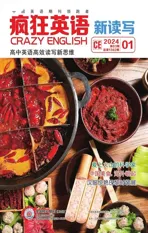澳大利亚的四合院
2024-03-03河北江东亮
河北 江东亮
主题语境:建筑与文化 篇幅:330词 建议用时:7分钟

1Women over 45 are one of the fastest-growing groups of people who are homeless in Australia. In 2020, an estimated 405,000 women over 45 were at risk of housing affordability stress and hence becoming homeless.Considering the shortage of affordable housing, an ageing population and the lifelong economic disadvantage that women experience, this problem requires a speedy solution.
2A simple solution for older women facing homelessness is to provide them with access to appropriate, safe and affordable homes for the long term. So why is this problem so difficult to solve? Recent attempts provide good short-term choices. But they do not create long-term housing that meets older women's needs to age in place and have a sense of belonging and safety.All these aspects are important for their well-being.
3Chinese courtyard housing—siheyuan—has some important principles that could be culturally adapted to the Australian background. The namesiheyuantranslates into quadrangle (四方院子) courtyard housing. This type of housing comes from traditional Confucian ideas of the extended family unit, arranged around a courtyard or series of courtyards with graduated levels of privacy.
4The interesting thing about thesiheyuanarrangement is the highly ordered series of rooms with private units organized around open spaces and halls for gatherings. The order ofsiheyuanpresents a great opportunity for adapting it to suit the needs of older women.It's a type of co-housing arrangement: People live independently but together, sharing some facilities like open spaces and areas to come together for occasional meals. This model could form part of the rise in shared housing.
5The courtyards meet the needs of older women to maintain a strong connection to a garden space.The courtyards promote exercise,as well as space for quiet contemplation(沉思). The hall serves as a social connector. It's a place for activities, connecting with family or friends, creative projects or listening. The private units ensure the independence, safety and sense of belonging that older women need. Cultural and social needs are met easily within one personal space.
Reading
Check
1.What problem does Australia meet according to the text?
A.There aren't enough houses.
B.There are too many homeless people.
C.More and more senior women are homeless.
D.Australians spend money too quickly.
2.What does the underlined word“they”refer to in paragraph 2?
A.The attempts to help the old women.
B.The problems the old women meet.
C.The houses built for the old women.
D.The requirements to have a sense of belonging.
3.What is the benefit ofsiheyuan?
A.It provides small rooms.
B.It is full of Chinese philosophy.
C.It can make people live longer.
D.It offers sharing and privacy.
4.Where can the old women connect with friends according to the last paragraph?
A.In the hall.
B.In the courtyards.
C.In the private units.
D.In the garden space.
Language
Study
Ⅰ.Difficult sentence in the text
Considering the shortage of affordable housing, an ageing population and the lifelong economic disadvantage that women experience,this problem requires a speedy solution.考虑到经济适用房短缺、人口老龄化以及妇女终生处于经济劣势,这个问题需要尽快解决。
【点石成金】本句中,Considering...affordable housing 作状语,considering 为介词。在英语中,有些动词的-ing形式具备介词的性质,常用的这类单词有regarding、concerning、respecting、including。句中的that引导定语从句,that在从句中作宾语。
Ⅱ.Fill in the blanks with the words and phrases in the box in proper forms.

To bridge the educational gap, we 1. ________the unique circumstances and extended access to quality education. We 2. ________the number of children in need and 3. ________the learning materials into multiple languages. By making the resources 4. ________, we ensured that it 5. ________every student, regardless of their economic backgrounds.Our efforts aimed to provide equal opportunities and empower the students to thrive academically. Through our determination, we have witnessed the power of education as it opens doors and empowers individuals to break free from the cycle of poverty. By working together,we can continue to make education 6. ________and inclusive for all.
